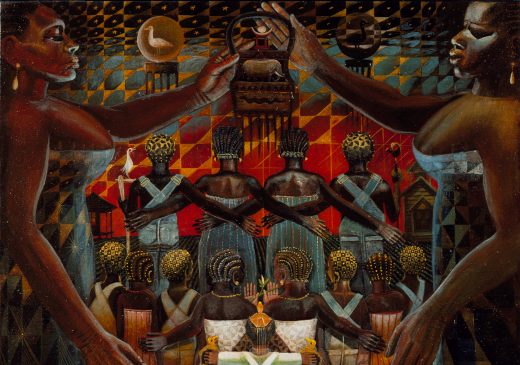DAY 1
- After completing Part 1 of Things Fall Apart, students will participate in a discussion with visual literacy questions on Untitled by John Thomas Biggers.
- Project a high-format image of Untitled in the classroom
- Begin by giving students time to “take in” and observe details in the painting
- Explain to students that the class will be participating in a structured discussion and seeking to make meaningful connections to Things Fall Apart
2 Start the discussion by asking students “What do you notice?”
- Try to orient responses to observations of detail within the painting.
- Repeat back observation to student and point to location of observed detail for the entire class to see.
- Even if a student makes a statement about what they believe to be happening in the painting, or what it may mean, redirect response to emphasize observation (“what details make you say that?”).
- Try to elicit a variety of responses from across the classroom – observation is an opportunity for reluctant students to easily participate and engage.
3 Once you’ve accumulated a room full of observations, ask students to build on those observations to ask questions about the painting.
- These statements should start with “I wonder…”.
- Repeat questions back to students, gesturing toward pertinent details in the painting.
- Resist the urge to answer the questions – ask the students to be curious and think about what they don’t know/what they want to know.
- Choose a few of the best questions and pose them to the students – see if they can figure it out on their own.
4 Build text-to-text connections – Ask students “What connections can you make between this painting and Things Fall Apart?”
- Use follow-up questions to challenge students to go beyond the superficial and make meaningful connections, or to analyze the connections
5 Small Group Discussion – Theme
- Put students in small groups of 4-5
- Task groups with developing a theme or message of the painting that also connects with Part 1 of Things Fall Apart
- Challenge groups to be precise and to clearly articulate how specific details of each work build toward a common theme
- After 5 minutes, give students the Discussion Reflection sheet to put their ideas to paper.
6 Introduce students to the photography project
- Pass out assignment handout
- Review assignment criteria, requirements, due dates, and rubric
- Discuss artist’s statement – emphasize that students are to use the skills and content they learned during the Elements of Photography presentation and practice to visually represent their theme
- Answer questions students may have about the project
7 Remind students that they have 1 week until their peer-critique session for their photographs. They must come with 3 “rough draft” photographs and be prepared to discuss their artistic process and thematic connections
DAY 2 (roughly 1 week later)
- Photography Project Peer Critique
- Each student is to bring in 3 “rough draft” photographs for their project. These photographs should be digital (on a student’s phone, a jump drive, email attachment, etc.)
- Students will meet with their peer critique groups (should not be the same groups as discussion in DAY 1 lesson) to share their work and receive feedback (students will complete a peer critique form very similar to what the groups usually do when critiquing essays)
Challenge groups to try and figure out the meaning the artist was hinting at without asking any questions of the artist.
Challenge groups to try to find thematic connections to Things Fall Apart now that the class is almost done with the book.
- At the end of the peer critique, students will select which concept/photograph they believe is their strongest. This is the photograph students will compose an artist’s statement on, and the photograph they will get printed out as an 8×10 on glossy photo paper.
- Remind students that the project is due in one week, and they must come to class with a 8×10 glossy photo print and the final draft of their artist’s statement.
Photos can be cheaply printed at Target, CVS, etc. for $2-$4.
DAY 3 (roughly 1 week later)
- Gallery
- Have students mount their 8×10 photo prints on some construction paper or pre-cut posterboard with some heavy-duty tape. They will probably need a reminder about doing this carefully, not placing tape on the front of the photo, and centering the photo on the paper/posterboard before taping it on.
- Clear out some wall space in advance so that students can tape their photos and artist statements to the wall. Students should place their artist statement next to their photograph
- Gallery Walk
- For the first round of the gallery walk, give each student 3 post-it notes and ask them to silently travel around the room visiting 10-15 photos. With the post-it notes, students should provide specific, constructive feedback on the elements of photography the artist used (perspective, framing, repetition, contrast, etc.)
- For the second round of the gallery walk, give each student 3 more post-it notes. Ask students to spend a bit more time with each photograph, browse artist statements, and provide constructive feedback on the thematic connections the artist made.
- Reflexión
- At the conclusion of the gallery walk, ask students to complete a brief reflection, in the style of a journal entry, responding to the following questions:
- What did participating in this photography project reveal to you about theme? About how authors construct theme in their work? About the theme of Things Fall Apart?

